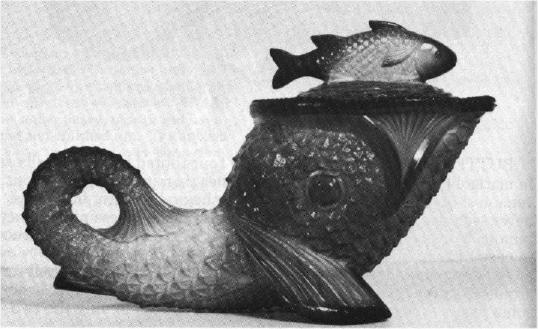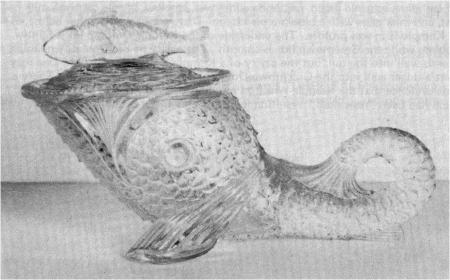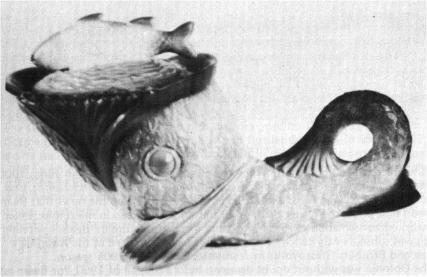National Depression Glass Association
Preserving America's Glass Manufacturing Heritage
Greentown's Fabulous Dolphin
by Dr. James S. Measell
Glass Review - October 1979
 Chocolate Beaded Edge Dolphin covered dish |
|---|
When the late Dr. Ruth Herrick published her pioneer work on Greentown Glass in 1959, she chose the Dolphin covered dish for her cover photo. The choice was a fitting one, indeed, and the Dolphin has since become the article most often identified with "Greentown Glass," i.e. the products of the Indiana Tumbler and Goblet Company (1894-1903). When my new book was in the planning stages, one of the easiest decisions made was to use the Dolphin on the cover of the softbound edition and on some of the promotional literature.
The Greentown Dolphin covered dish was designed by Charles E. Beam, who first came to work at the Indiana Tumbler and Goblet Company in about 1897, where he was in charge of the mould shop. Before coming to Greentown, Beam had had much experience in Ohio Valley glass factories and at the famous Hipkins Novelty Mould Shop in Martins Ferry, Ohio. Beam may have had his own mould shop in Wellsburg, West Virginia, for a short time at least. When the Greentown plant was taken over by the National Glass Company in 1899, Beam remained in charge of the design mould making operations there. The National announced a glassware design contest in late 1899, and Beam's entries were among some 175 submissions to the competition. When the awards were announced in June, 1900, the glass trade papers -- Crockery and Glass Journal; China, Glass and Lamps; and Housefurnisher: China, Glass and Pottery Review -- all carried the news that Beam had won first prize, the rather substantial sum of $500 (keep in mind that skilled glass workers earned about $15 for a 55 hour week at this time) - Beam's winning design was subsequently called "Prize" and was manufactured at the National's McKee and Brothers Glass Works in Jeannette, PA, for the 1901 season.
The Dolphin was without doubt designed before the fall of 1900, for Beam had left Greentown by then to follow D. C. Jenkins, Jr., to Kokomo, Indiana. Jenkins was instrumental in forming the National Glass Company, but he soon became disenchanted with the combine and decided to go his own way. When he left Greentown for nearby Kokomo, a number of Greentown's workers followed.
 Clear Beaded Edge Dolphin covered dish |
|---|
The Dolphin was probably successful in terms of sales, and there are three different ways in which the Dolphin's large open mouth may occur:
- The "pleated" or sawtooth variant which has ten teeth on each side of the mouth
- The "beaded edge" variant which has a continuous striated band around the circumference of the mouth
- The smooth edge variant
Both the sawtooth and the beaded edge variants are known in amber, Cobalt blue, clear, emerald green, and Chocolate glass. The sawtooth is also known in teal blue, canary and opaque white, and the beaded edge occurs in opaque Nile green and Golden Agate (Holly Amber). The smooth edge has been found only in Chocolate glass. The Dolphin, like other animal dishes of this era, was a likely item for grocers to give as a premium with the purchase of food stuffs. Dr. Herrick felt strongly the Dolphins were used as mustard containers, too.
Reproductions of Greentown's Dolphin have become a matter of concern to collectors in recent years, but these are quite easy to detect. First of all, only the sawtooth Dolphin has been reproduced. The Kemple Glass Works made the Dolphin in the 1950s, and the St Clair Glass Co. made it in the 1960s and 70s. The mould used by Kemple is now the property of the Wheaton firm in New Jersey, and the St. Clair mould is now being used by the Summit Art Glass Company of Mogadore, Ohio.
The Kemple-Wheaton Dolphin is known in clear, light and dark amber, cobalt and teal blue, emerald green, amberina, amethyst, vaseline, purple carnival, milk glass, and milk glass with a blue marble effect. There are probably other colors, as the Kemple firm was prolific. The underside of the Kemple Dolphin lid is faintly pebbled, while the Greentown lid is smooth. The Cavity of the Greentown Dolphin extends well into the tail but the cavity of a Kemple Dolphin is smaller. One may insert a finger well into the Greentown Dolphin -- not so with the Kemple. There is some evidence that the Kemple-Wheaton mould is derived from an original mould which had been reworked resulting in these detailed differences.
 Reproduction St. Clair-Summit Dolphin covered dish |
|---|
The St. Clair-Summit Dolphin is made from an entirely different mould. The major detail difference between these and the Greentown Dolphin is quite easy to detect. The Greentown Dolphin has ten teeth on each side, while the St. Clair-Summit Dolphin has ten on one side and nine on the other (this test does not, of course, apply to the Kemple-Wheaton Dolphin}. St. Clair made the Dolphin in small runs of marigold carnival (Ca. 1967} and dark purple (Ca. 1970). In 1974, the St Clair "chocolate" Dolphin was made; many are signed "Joe St. Clair" inside the base but a number of unsigned ones are known. The Summit Dolphins are found in both an attractive powder blue and a red-orange slag. These are marked with the trade mark of Summit's owner, Russell Vogelsong, a "V" in a circle.
The distinctive Dolphin will always be an eye-catching article among the shelves of any collection. Dr. Herrick called it a "fantasy," since real Dolphins don't have scales, but reality has not stood in the way of glass designers in the tradition of Charles E. Beam!
* About the author: Dr. Measell is a professor at Wayne State University in Michigan and is the author of Guide to Reproductions of Greentown Glass and a new book entitled Greentown Glass: The Indiana Tumbler and Goblet Company.